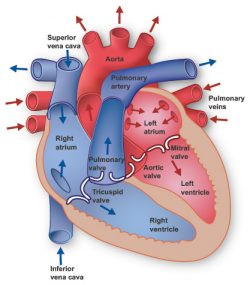Your heart is a vital organ responsible for pumping blood throughout your body, delivering oxygen and nutrients to every cell. Understanding where your heart is located and its basic anatomy is crucial for appreciating its function and maintaining your cardiovascular health.
Your heart is positioned in the center of your chest, nestled between your lungs. More specifically, it sits behind and slightly to the left of your breastbone, also known as the sternum. This central location within the chest cavity provides protection while allowing the heart to function efficiently.
 Diagram illustrating the anatomical location of the human heart within the chest, highlighting its position relative to the lungs and sternum.
Diagram illustrating the anatomical location of the human heart within the chest, highlighting its position relative to the lungs and sternum.
The heart is enclosed in a protective sac called the pericardium. This double-layered membrane acts like a cushion, safeguarding the heart and allowing it to move smoothly as it beats. The outer layer of the pericardium is anchored to major blood vessels and connected to your spine, diaphragm, and other surrounding structures, providing stability. A lubricating fluid separates the two layers of the pericardium, minimizing friction as the heart contracts and expands.
While often perceived as large, the average adult heart is only about the size of your fist, weighing between 7 to 15 ounces (200 to 425 grams). Despite its relatively small size, the heart is an incredibly powerful muscle. Over an average lifetime, your heart may beat more than 3.5 billion times. On a daily basis, it beats around 100,000 times, pumping approximately 2,000 gallons (7,571 liters) of blood throughout your body.
Inside, the heart is divided into four chambers: two upper chambers called atria (left and right atrium) and two lower chambers called ventricles (left and right ventricle). A muscular wall, known as the septum, separates the left and right sides of the heart. The left ventricle is the largest and strongest chamber, responsible for pumping oxygen-rich blood out to the entire body. Despite having walls only about half an inch thick, the left ventricle generates enough force to propel blood through the aortic valve and into the aorta, the body’s largest artery.
To ensure blood flows in the correct direction, the heart has four valves:
- Tricuspid valve: Regulates blood flow between the right atrium and the right ventricle.
- Pulmonary valve: Controls blood flow from the right ventricle into the pulmonary arteries, which carry blood to the lungs to receive oxygen.
- Mitral valve: Allows oxygen-rich blood from the lungs to flow from the left atrium into the left ventricle.
- Aortic valve: Opens to allow oxygen-rich blood to pass from the left ventricle into the aorta, and subsequently to the rest of the body.
The heart’s rhythmic contractions are controlled by an electrical conduction system. Electrical impulses originate in the sinoatrial (SA) node, often referred to as the heart’s natural pacemaker, located in the right atrium. This SA node generates electrical signals that travel through the heart muscle fibers, causing the atria and ventricles to contract in a coordinated manner. While the SA node establishes a baseline heart rate, factors like physical activity, stress, and hormones can influence and adjust your heart rate as needed.
Working in conjunction with blood vessels, the heart forms the cardiovascular system, also known as the circulatory system. The heart acts as a central pump, propelling blood through a vast network of arteries, arterioles, and capillaries to deliver oxygen and nutrients to every organ, tissue, and cell in your body. Simultaneously, the blood collects carbon dioxide and waste products, carrying them back to the heart through venules and veins for removal from the body. The extensive network of blood vessels in your body is truly remarkable. If laid end-to-end, they would stretch approximately 60,000 miles (over 96,500 kilometers), long enough to circle the Earth more than twice!
Understanding the location and anatomy of your heart provides a foundation for appreciating its incredible role in sustaining life. Taking care of your heart through a healthy lifestyle is essential for ensuring its continued function and overall well-being.

